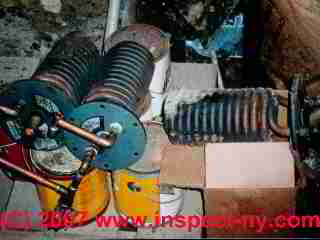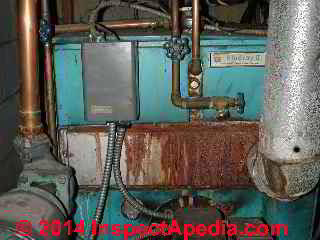 Tankless Coil Internal Leak Into the Heating Boiler
Tankless Coil Internal Leak Into the Heating Boiler
How to Diagnose, Evaluate & Repair Leaks at a Tankless Coil on a Heating Boiler
- POST a QUESTION or COMMENT about the types of leaks that occur on tankless coils, where they are found, what problems the leaks cause, and a leaky tankless coil can be repaired, or if necessary, replaced.
Tankless hot water coil leaks into the boiler:
How does a tankless coil internal or hidden leak develop? Why does a tankless coil leak into the heating boiler rather than the other way around?
This article explains that leaks in the hot water heating tankless coil can cause abnormally high heating boiler pressure, leaks at the boiler temperature & pressure relief valve, and it explains why that is dangerous.
Leaks can occur at a tankless coil where it is mounted to the top or side of a heating boiler, at fittings connecting hot and cold water piping to the coil, and more subtle leaks can occur inside the boiler - leading to excessive boiler pressure and relief valve leaks.
InspectAPedia tolerates no conflicts of interest. We have no relationship with advertisers, products, or services discussed at this website.
- Daniel Friedman, Publisher/Editor/Author - See WHO ARE WE?
Internal Leaks from a tankless coil into the heating boiler will raise boiler pressure
 A tankless coil water heater places the coil inside the heating boiler and circulates building water inside the coil. Heat is transferred from the boiler water through the coil surfaces into the building potable water supply running inside the coil.
A tankless coil water heater places the coil inside the heating boiler and circulates building water inside the coil. Heat is transferred from the boiler water through the coil surfaces into the building potable water supply running inside the coil.
[Click to enlarge any image]
Watch out for this second and more tricky to spot tankless coil leak.
Corrosive water, usage, repeated acid cleanout of a mineral-clogged tankless coil, or other wear and tear can cause the finned copper tubing of the tankless coil to leak water at house pressure into the interior of the heating boiler itself.
A leak in the coil will typically allow higher pressure building potable water to leak out of the coil and into the heating boiler, raising its pressure and causing TPR spillage.
Take a look at that pile of tankless coils in our photo (left). When we found all three of these near the heating boiler in a home we knew that there had been a history of trouble with leaky tankless coils. You can see in the photo (click to enlarge) that there is virtually no rust or corrosion around the coil mounting plate.
You would never spot this leak by just looking at the boiler externally. But each of the three coils has some funny-looking brass-colored discoloration around the finned tubing near the mounting plate, in the first three coil turns
That's just where you might find thin coil tubing and perforations due to one of the causes we list below.
Leaks from a tankless coil into the heating boiler may first show up as a mysterious dripping leak at the heating boiler's temperature & pressure relief valve.
See RELIEF VALVE LEAKS
Causes of Internal Leaks in a Tankless Coil or in the Heat Exchanger Coil of an Indirect Water Heater
- Corrosive water: Building water supply that has a high corrosive index
- High mineral content in water: Building water supply high in minerals, leading to clogging of the tankless coil, combined with repeated acid washings to try to clear the blocked coil. Acid used to clean a tankless coil may eventually cause thinning of the copper and may contribute to perforation and coil leaks.
- Mechanical damage: (Rare) mechanical damage to the coil itself during shipment, storage, or installation
- Water quantity usage: unusually high usage rate of domestic hot water may contribute to water piping and tankless coil corrosion, especially if the corrosivity index of the water supply is high.
External leaks at the tankless coil (photo) are more likely to cause boiler leaks out rather than coil leaks in to the boiler.
Our photo (above- left) illustrates leaks around the tankless coil (top center on this boiler) mounted so that little of the coil itself is visible - it's hidden by the blue BlueRay II boiler mounting jacket. But the rust stains below the boil make the leak obvious. Information about carbon monoxide hazards concerning this boiler is
Watch out: under normal conditions, because building water supply pressures are above boiler pressures, an internal leak in the tankless coil will cause boiler pressures to rise. But there can be exceptions in the direction of water leakage, as we explain
at TANKLESS COIL LEAK DIRECTION IN or OUT
Leaks at tankless coils on heating boilers can seep away for a long time before anyone notices. But if you wait too long, the boiler may be beyond repair.
Question: can water leak from the boiler into the home hot water piping system?
2018/01/16 Mag said:
Thank you for the valuable information provided on the site. Regarding leaking from or into the heating coil I believe I have a situation in which boiler water is entering into the coil, i.e. there was a strong smell of antifreeze, but fortunately it was food grade type.
Apparently all antifreeze has been exhausted. I've continued to use the furnace to heat the house and provide hot water. In this scenario where boiler water is entering coil I've assumed the greater pressure is outside the coil, in the boiler water side.
What would cause boiler to over pressurize? I realize I should replace the coil if it has leaks, but is it possible that the boiler water is entering house hold hot water via the expansion tank? Many thanks for your help.
This question and our reply were posted originally
Reply: yes
Mag
Boiler water might leak into a tankless coil IF boiler pressure is above the house water system pressure.
A residential heating boiler won't get above 30 psi since at that pressure the TPR valve would open and spill water and pressure and temperature.
Home water supply systems can indeed sometimes be lower than 30 psi, such as on a private well system at which the water pressure ranges between 20 psi and some higher cut-off pressure (typically 40 psi). A home water system connected to a municipal supply is usually above 30 psi but not always and not in all locations.
So yes, it's possible for boiler water, including antifreeze if the boiler system contains that chemical, to leak out of the boiler into the home's hot water piping system and thus to come out at hot water faucets.
The water leak can be in either direction - into the coil from the building water supply (when house pressure is higher than boiler pressure) or out of the coil and into the building water supply piping (when house pressure is lower than boiler pressure).
If house water is leaking into the heating boiler system that can raise the boiler's cold-state pressure above its normal pressure range (around 12 to 18 psi). Then when the boiler heats up on a heating cycle its pressure may indeed be abnormally high. A symptom might be spillage at the relief valve.
Check the heating boiler pressure gauge when the boiler is hot. If the gauge is reading at 30 psi or above I would expect the TPR valve to be spilling.
Check the heating boiler pressure gauge when the boiler is cold. I would expect the gauge to read 12-18 psi depending on the height of your home.
Boiler pressures range from about 12 psi (boiler cold) to 29 psi (boiler hot).
House water system pressures range from typically around 20 psi to about 70 psi.
Also see TANKLESS COIL LEAK DIRECTION IN or OUT
...
Continue reading at TANKLESS COIL LEAK DIRECTION IN or OUT or select a topic from the closely-related articles below, or see the complete ARTICLE INDEX.
Or see these
Recommended Articles
- BOILER LEAKS CORROSION STAINS
- TANKLESS COIL / HOT WATER COIL LEAKS
- TANKLESS COIL EXTERNAL LEAK SPOTS
- TANKLESS COIL EXTERNAL LEAK EVALUATION
- TANKLESS COIL RUST TYPES: SUPERFICIAL vs EXFOLIATION
- TANKLESS COIL INTERNAL LEAKS INTO the BOILER
- INDIRECT WATER HEATER COIL LEAKS INTO the BOILER
- TANKLESS COIL LEAK DIRECTION IN or OUT
- EVIDENCE of TANKLESS INTERNAL COIL LEAK INTO BOILER / WATER TANK
- REPAIR OPTIONS for TANKLESS COIL LEAKS
Suggested citation for this web page
TANKLESS COIL INTERNAL LEAKS INTO the BOILER at InspectApedia.com - online encyclopedia of building & environmental inspection, testing, diagnosis, repair, & problem prevention advice.
Or see this
INDEX to RELATED ARTICLES: ARTICLE INDEX to HEATING BOILERS
Or use the SEARCH BOX found below to Ask a Question or Search InspectApedia
Or see
INDEX to RELATED ARTICLES: ARTICLE INDEX to WATER HEATERS
Or use the SEARCH BOX found below to Ask a Question or Search InspectApedia
Ask a Question or Search InspectApedia
Try the search box just below, or if you prefer, post a question or comment in the Comments box below and we will respond promptly.
Search the InspectApedia website
Note: appearance of your Comment below may be delayed: if your comment contains an image, photograph, web link, or text that looks to the software as if it might be a web link, your posting will appear after it has been approved by a moderator. Apologies for the delay.
Only one image can be added per comment but you can post as many comments, and therefore images, as you like.
You will not receive a notification when a response to your question has been posted.
Please bookmark this page to make it easy for you to check back for our response.
IF above you see "Comment Form is loading comments..." then COMMENT BOX - countable.ca / bawkbox.com IS NOT WORKING.
In any case you are welcome to send an email directly to us at InspectApedia.com at editor@inspectApedia.com
We'll reply to you directly. Please help us help you by noting, in your email, the URL of the InspectApedia page where you wanted to comment.
Citations & References
In addition to any citations in the article above, a full list is available on request.
- Mark Cramer Inspection Services Mark Cramer, Tampa Florida, Mr. Cramer is a past president of ASHI, the American Society of Home Inspectors and is a Florida home inspector and home inspection educator. Mr. Cramer serves on the ASHI Home Inspection Standards. Contact Mark Cramer at: 727-595-4211 mark@BestTampaInspector.com
- John Cranor [Website: /www.house-whisperer.com ] is an ASHI member and a home inspector (The House Whisperer) is located in Glen Allen, VA 23060. He is also a contributor to InspectApedia.com in several technical areas such as plumbing and appliances (dryer vents). Contact Mr. Cranor at 804-873-8534 or by Email: johncranor@verizon.net
- In addition to citations & references found in this article, see the research citations given at the end of the related articles found at our suggested
CONTINUE READING or RECOMMENDED ARTICLES.
- Carson, Dunlop & Associates Ltd., 120 Carlton Street Suite 407, Toronto ON M5A 4K2. Tel: (416) 964-9415 1-800-268-7070 Email: info@carsondunlop.com. Alan Carson is a past president of ASHI, the American Society of Home Inspectors.
Thanks to Alan Carson and Bob Dunlop, for permission for InspectAPedia to use text excerpts from The HOME REFERENCE BOOK - the Encyclopedia of Homes and to use illustrations from The ILLUSTRATED HOME .
Carson Dunlop Associates provides extensive home inspection education and report writing material. In gratitude we provide links to tsome Carson Dunlop Associates products and services.


